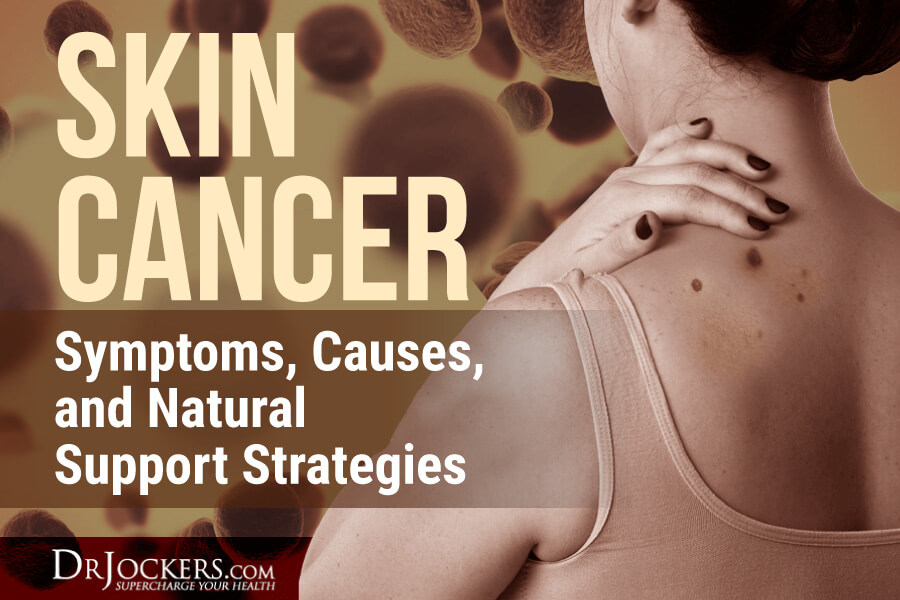 Skin Cancer: Symptoms, Causes, and Natural Support Strategies
Skin Cancer: Symptoms, Causes, and Natural Support Strategies
Skin cancer is the most common form of cancer in the United States. Around 9,500 Americans are diagnosed with skin cancer every day, and more than 2 people die of skin cancer every hour. Discover the most common symptoms, root cause factors, and natural support strategies for skin cancer.
The two most common types of skin cancer are basal cell carcinoma and squamous cell carcinoma. A less common but more aggressive type of skin cancer is melanoma.
Exposure to ultraviolet (UV) radiation from the sun or tanning machines is the major cause of skin cancer. The main symptom of skin cancer is a new or changing bump, growth, lesion, mole, or rough patch of skin. These are usually found on parts of the body that are repeatedly exposed to the sun but can appear anywhere on the body.
Conventional treatments for skin cancer include removal of the mole or lesion with surgery, freezing, medicated creams, or laser therapy. Chemotherapy, radiation, biological therapy, and targeted therapy may also be used. Fortunately, there are natural strategies you can implement to help prevent skin cancer and support the body’s ability to fight skin cancer. These strategies will be discussed in this article.
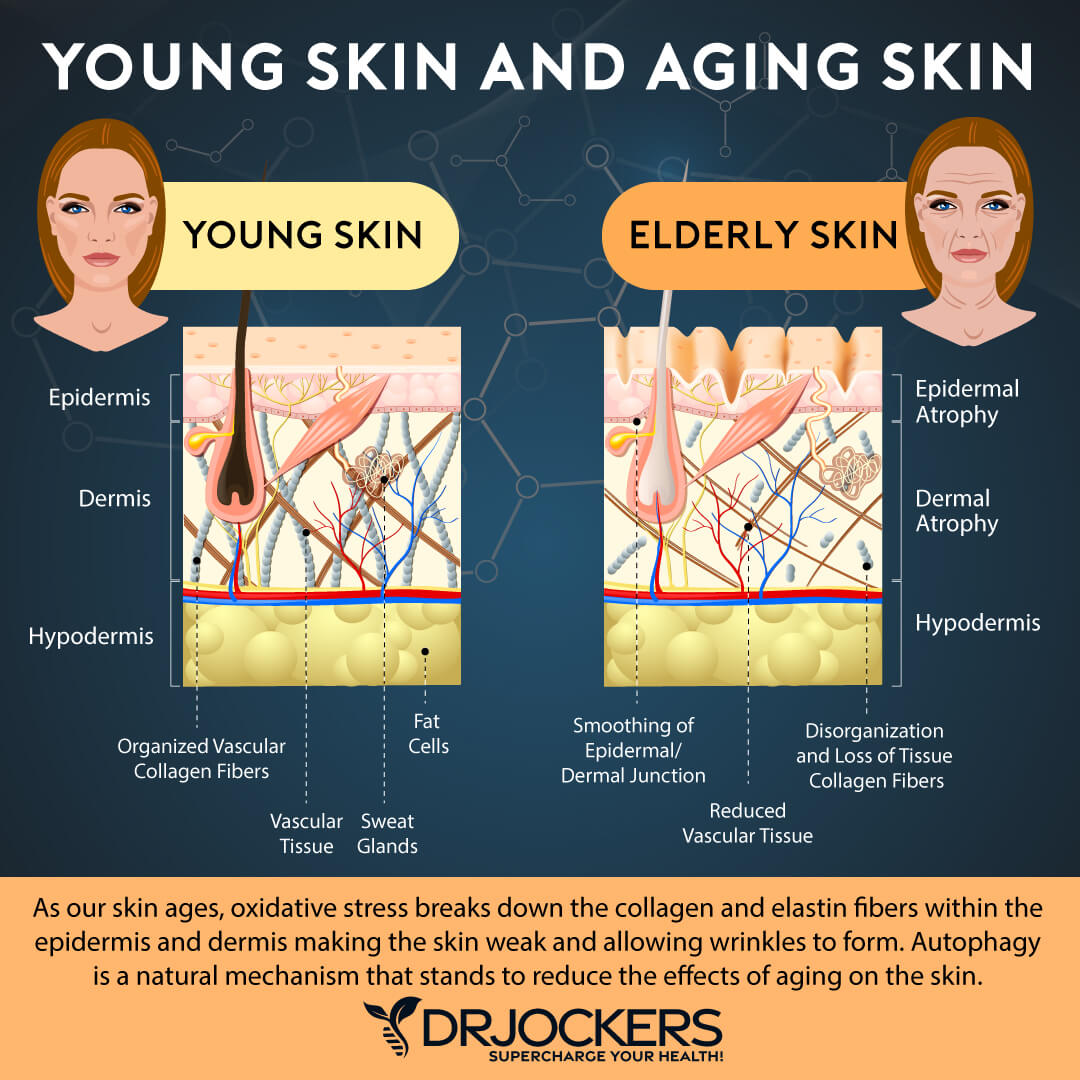
The Skin
The skin is the outer covering and largest organ of the body. It is a vital and complex organ containing around 650 sweat glands, 20 blood vessels, and more than 1,000 nerve endings per square inch. The skin consists of two main layers: the outer epidermis and the inner dermis.
The skin has many important functions, including:
- Serving as a protective barrier that interacts with our environment.
- Shielding the delicate, sensitive tissues underneath from injuries.
- Playing an active role in the immune system by protecting the body from microorganisms.
- Guarding against excessive exposure to the ultraviolet rays of the sun by producing a protective pigmentation, helps produce the body’s supply of vitamin D.
- Helping to regulate body temperature and to eliminate wastes in the form of perspiration; and,
- Gathering sensory information from the surrounding environment enables the body to feel pain, cold, heat, touch, and pressure.
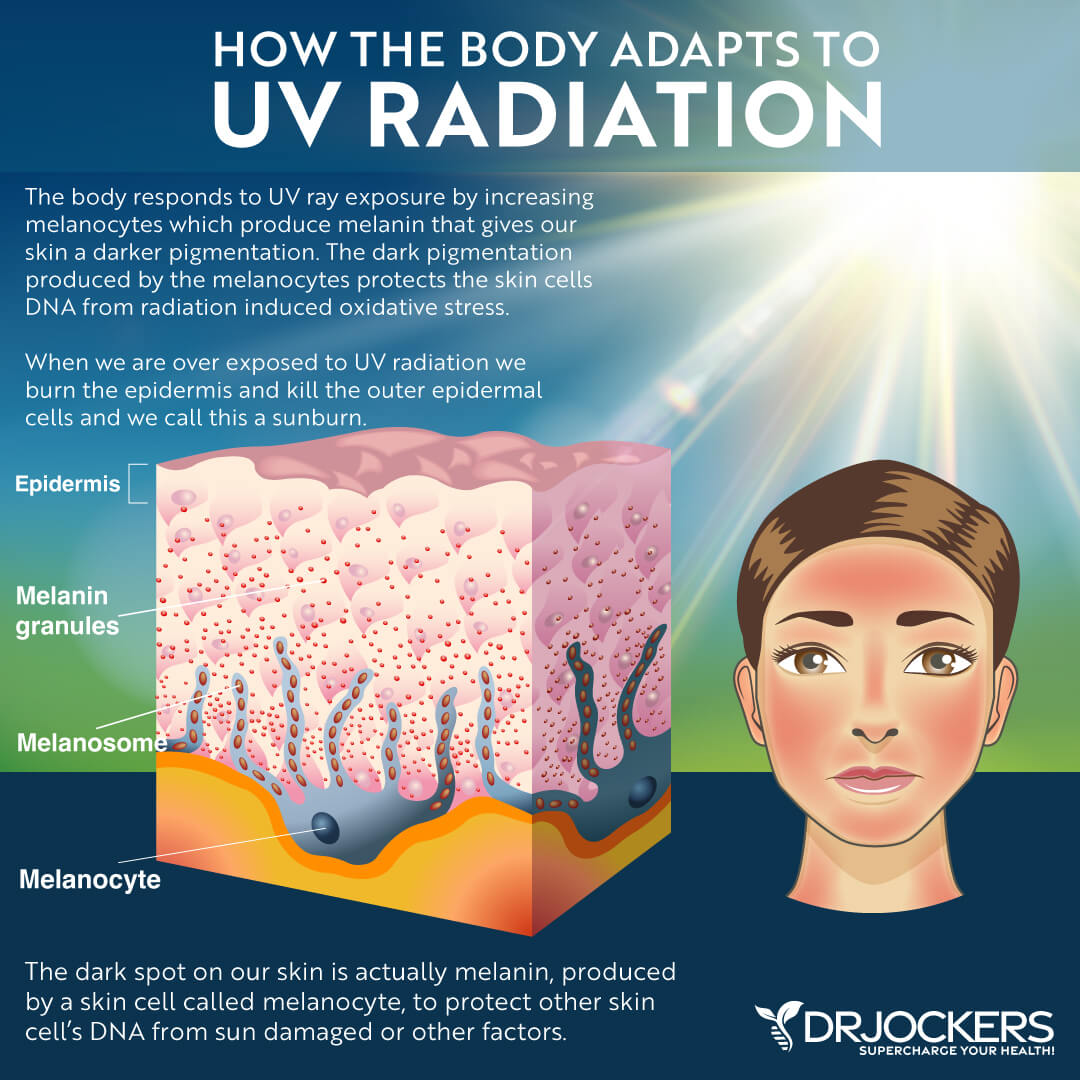
Skin Cancer
Skin cancer is the abnormal growth of skin cells. It is the most common cancer in the United States and worldwide. In fact, more people are diagnosed with skin cancer each year in the U.S. than all other cancers combined (1). At least 20% of Americans will develop skin cancer by the age of 70.
About 90% of nonmelanoma skin cancers are the result of too much exposure to ultraviolet light. This is found in sunlight and indoor tanning devices.
Most skin cancers occur on parts of the body that are repeatedly exposed to the sun. These areas include the head, neck, face, tips of the ears, hands, forearms, shoulders, back, chest, and legs.
Skin cancer can also occur in areas of the body not ordinarily exposed to the sun. These include between the toes, the palms, the genital area, or under a nail. Skin cancer is usually one of the most curable types of cancer. Here is the data on skin cancer from Summa Health and the American Cancer Society
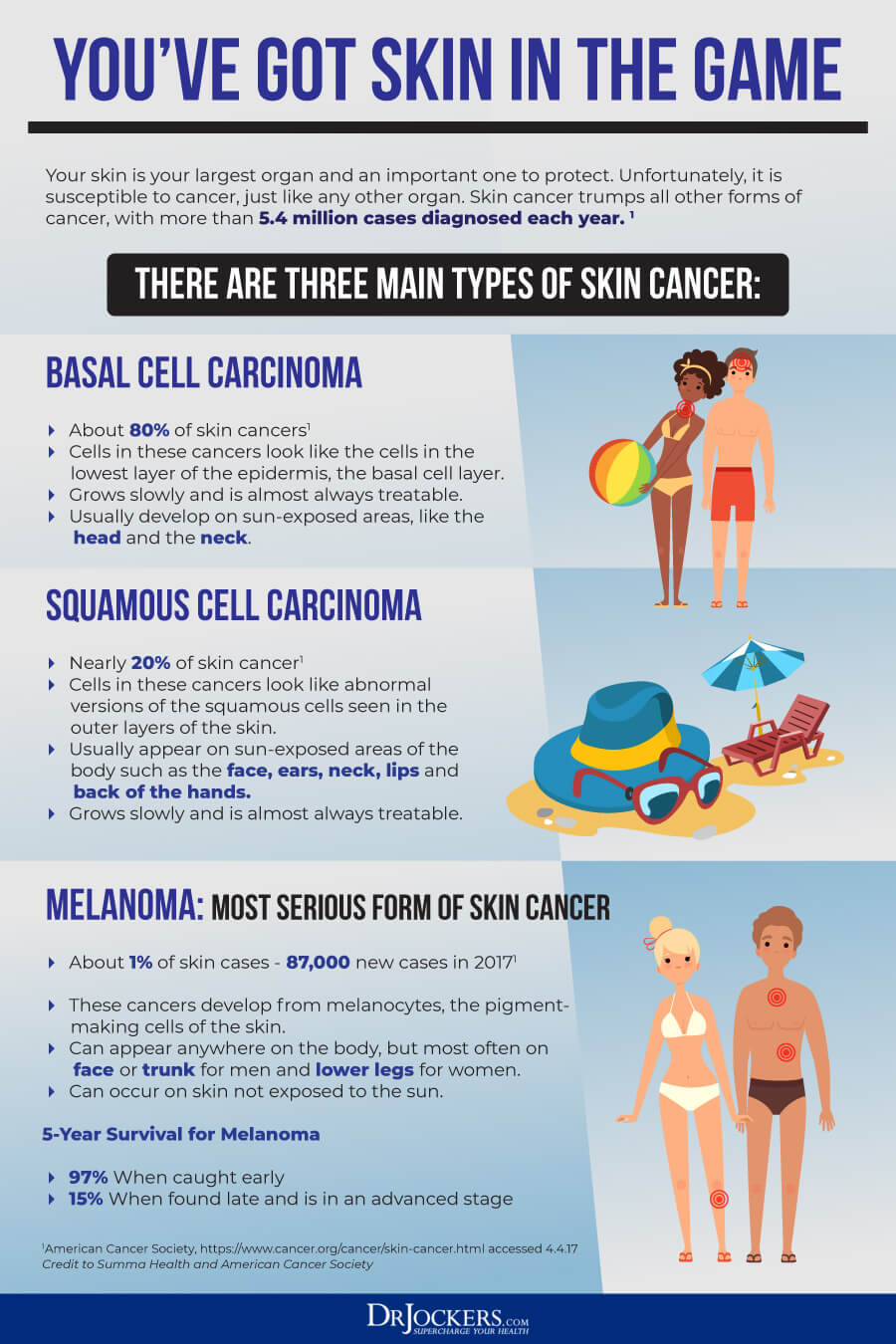
Types of Skin Cancer
There are three major types of skin cancer. Basal cell carcinoma (BCC) and squamous cell carcinoma (SCC) are referred to together as nonmelanoma skin cancers. These cancers occur in the basal and squamous cell layers at the top of the skin. These superficial skin cancers are almost always slow-growing and do not spread. If found early, they are easy to treat and do not spread.
The third main type of skin cancer is melanoma. Melanoma is less common than BCC and SCC but is the most aggressive form of skin cancer. In the past decade, the number of new invasive melanoma cases increased by 47% (1).
Less common types of skin cancers include Kaposi sarcoma, Merkel cell carcinoma, and sebaceous gland carcinoma.
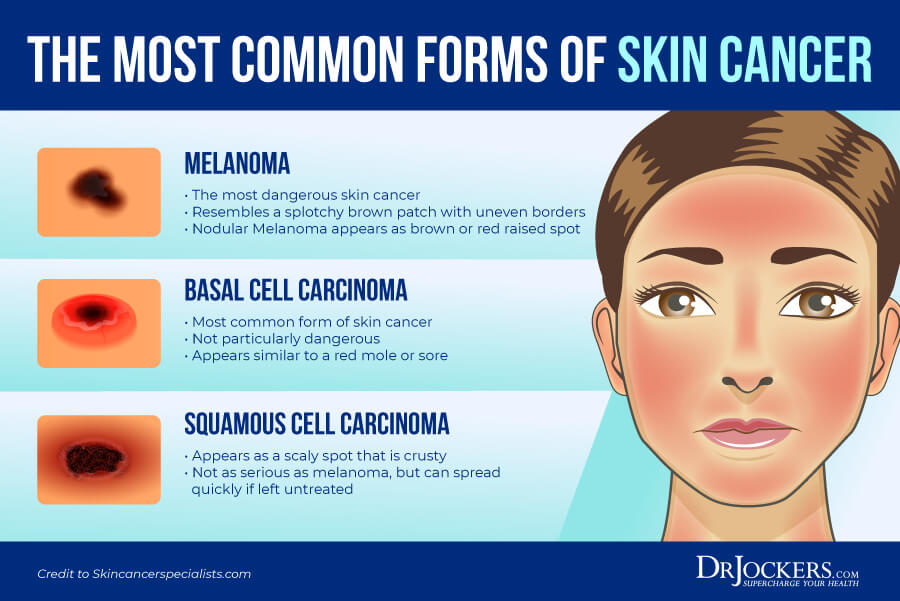
Basal Cell Carcinoma
Basal cell carcinoma is the most common form of skin cancer. This skin cancer begins in the basal cells, a type of cell within the skin that produces new skin cells as old ones die off. Basal cell carcinoma usually develops on sun-exposed parts of your body, especially your head and neck. Less often, basal cell carcinoma can develop on parts of your body usually protected from the sun, such as the genitals.
Basal cell carcinoma appears as a change in the skin, such as a growth or a sore that will not heal. These changes in the skin (lesions) usually have one of the following characteristics:
- A pearly white, skin-colored, or pink bump that is translucent, meaning you can see a bit through the surface. Tiny blood vessels are often visible. In people with darker skin tones, the lesion may be darker but still somewhat translucent. The most common type of basal cell carcinoma, this lesion often appears on the face and ears. The lesion may rupture, bleed, and scab over.
- A brown, black, or blue lesion with a slightly raised, translucent border.
- A flat, scaly, reddish patch with a raised edge is more common on the back or chest. Over time, these patches can grow quite large.
- A white, waxy, scar-like lesion without a clearly defined border, called morpheaform basal cell carcinoma, is the least common.
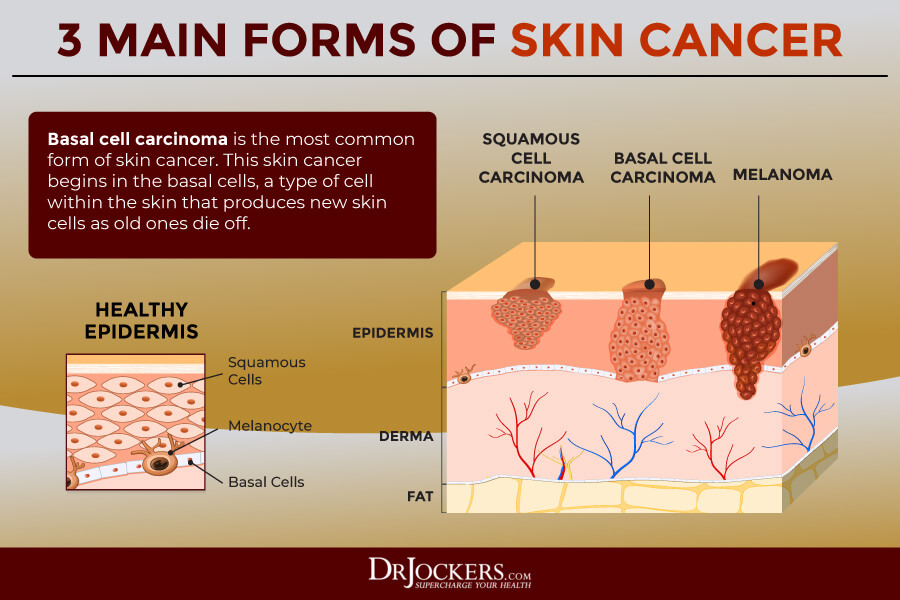
Squamous Cell Carcinoma
Squamous cell carcinoma (SCC) of the skin is a common form of skin cancer that develops in the cutaneous squamous cells. These cells make up the middle and outer layers of the skin. Squamous cells are found in many other places in your body, and squamous cell carcinoma can occur anywhere squamous cells are found.
Squamous cell carcinoma can be aggressive. Untreated, squamous cell carcinoma of the skin can grow large or spread to other parts of your body, causing serious complications.
SCC of the skin most often occurs on sun-exposed skin, such as your scalp, the backs of your hands, your ears, or your lips. But it can occur anywhere on your body, including inside your mouth, the bottoms of your feet, and on your genitals.
Squamous cell carcinomas can appear as scaly red patches, open sores, rough, thickened, or wart-like skin, or raised growths with a central depression. At times, these may crust over, itch, or bleed.
Signs and symptoms of squamous cell carcinoma of the skin include:
- A firm, red nodule
- A flat sore with a scaly crust
- A new sore or raised area on an old scar or ulcer
- A rough, scaly patch on your lip that may evolve into an open sore
- A red sore or rough patch inside your mouth
- A red, raised patch or wart-like sore on or in the anus or on your genitals
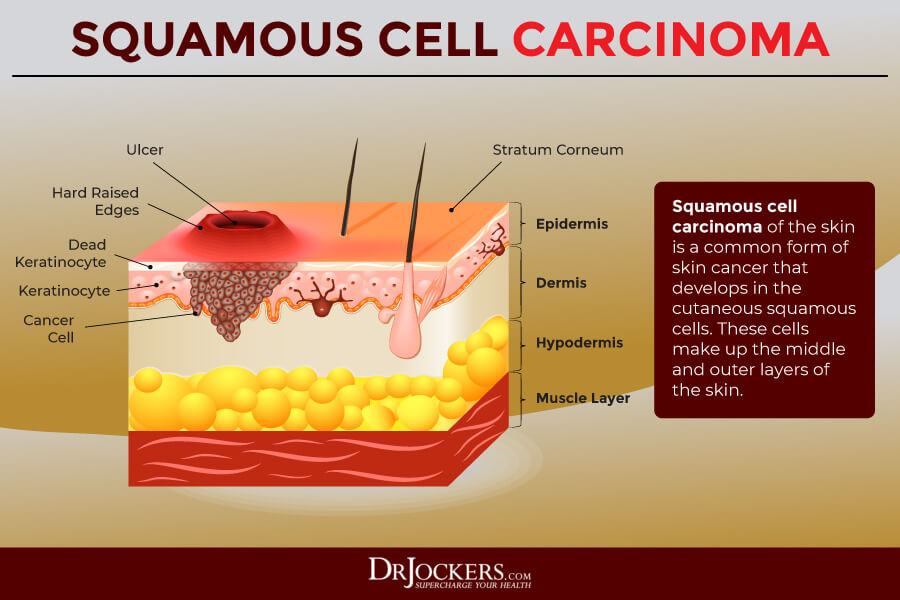
Melanoma
Melanoma occurs in skin cells that make a skin color pigment called melanin (melanocytes). Melanocytes are found in the upper layer of the skin. Melanoma occurs when DNA damage from UV radiation triggers mutations or changes in the melanocytes, resulting in uncontrolled cellular growth.
If it is not found early, melanoma will likely spread to other tissues. Only 2% of skin cancer cases are melanoma, but it causes the most deaths from skin cancer.
Early detection of melanoma is critical. The 5-year survival rate if melanoma is detected early is 99%. The survival rate drops to 65% if the disease reaches the lymph nodes and 25% if it spreads to organs (2).
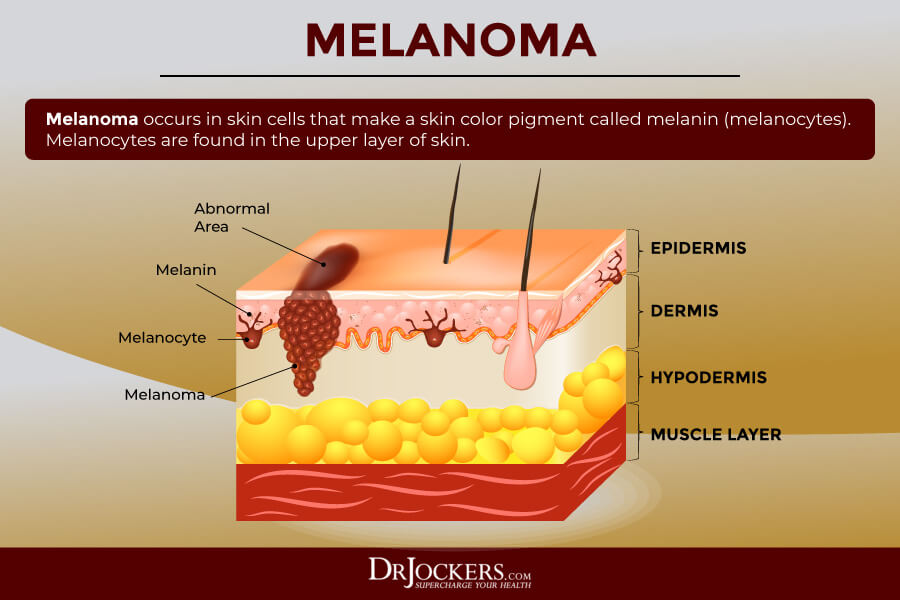
ABDCD Rule to Detect Melanoma
The main symptom of melanoma is a new or changing bump, growth, lesion, mole, or rough patch of skin. Not all melanomas look alike. Melanomas come in many forms and may not display any of the typical warning signs. About 20-30% of melanomas develop in existing moles, while 70-80% arise on normal skin. (2).
A normal mole is a solid tan, brown, dark brown, or flesh-colored. It has a round or oval shape with well-defined edges. Normal moles are usually smaller than 1/4 inch in diameter and are flat or dome-like.
The ABCDE rule can help distinguish a normal mole from a cancerous mole. If you notice any of these signs, you should talk to your doctor right away.
- A for Asymmetry: Most melanomas are not symmetrical. This means it is not the same on both sides. If it was folded in half, the two halves would not match.
- B for Border: Melanoma borders tend to be uneven and may have scalloped or notched edges rather than smooth, even borders.
- C for Color: Multiple colors, such as different shades of brown, tan, or black, are a warning sign for melanoma. Also look for darkening, loss of color, spreading color, or other changes in the color of the mole.
- D for Diameter or Dark: A mole more than ¼ inch in diameter (the size of a pencil eraser) is a warning sign.
- E for Evolving: A mole looks different from others or is changing in shape, size, or color. A new symptom in the mole such as bleeding, itching, or crusting may be a warning sign of melanoma.
The “ugly duckling” is another warning sign for melanoma. Melanomas typically stand out like ugly ducklings in comparison to most moles on the body. Melanomas can also develop in areas of your body that have little or no exposure to the sun, such as the spaces between your toes and on your palms or soles, on the scalp, under a nail, and in the eye, mouth, digestive tract, urinary tract, or vagina.
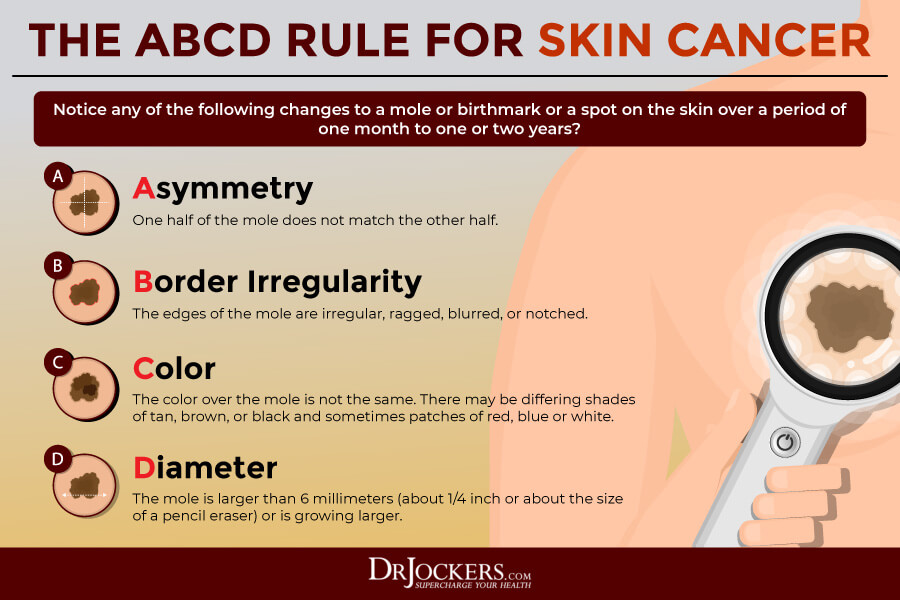
Risk Factors and Causes of Skin Cancer
Most of the DNA mutations in skin cells are caused by ultraviolet (UV) radiation found in sunlight and in commercial tanning lamps and tanning beds. But sun exposure doesn’t explain skin cancers that develop on skin not ordinarily exposed to sunlight. This indicates that other factors may contribute to your risk of skin cancer, including genetic and environmental factors.
Factors that may increase your risk of skin cancer include:
- Fair skin: Having less pigment (melanin) in your skin provides less protection from damaging UV radiation. People with blond or red hair and light-colored eyes and those who freckle or sunburn easily, are much more likely to develop skin cancer than is a person with darker skin.
- Excessive sun exposure
- Use of indoor tanning devices
- A history of sunburns, especially severe or blistering sunburns
- A personal history of precancerous skin lesions, such as actinic keratosis or Bowen’s disease
- A personal or family history of skin cancer
- Weakened immune system: People with weakened immune systems have an increased risk of skin cancer. This includes people who have leukemia or lymphoma and those who take medications that suppress the immune system, such as those who have undergone organ transplants.
- Photosensitivity: Photosensitivity is heightened skin sensitivity or an unusual reaction when your skin is exposed to UV radiation from sunlight or a tanning bed. You can become photosensitive as a result of prescription or over-the-counter medications, a medical condition, or a genetic disorder, or even by using certain types of skin care products.
- Radiation therapy to treat acne or other skin conditions may increase the risk of skin cancer at previous treatment sites on the skin.
- Inherited syndromes that cause skin cancer: Certain rare genetic diseases including nevoid basal cell carcinoma syndrome (Gorlin-Goltz syndrome) and xeroderma pigmentosum, which causes extreme sensitivity to sunlight, have a greatly increased risk of developing skin cancer.
- Exposure to arsenic: Arsenic, a toxic metal that’s found widely in the environment, increases the risk of basal cell carcinoma and other cancers. Everyone has some arsenic exposure because it occurs naturally. However, some people may have higher exposure if they drink contaminated well water or have a job that involves producing or using arsenic.
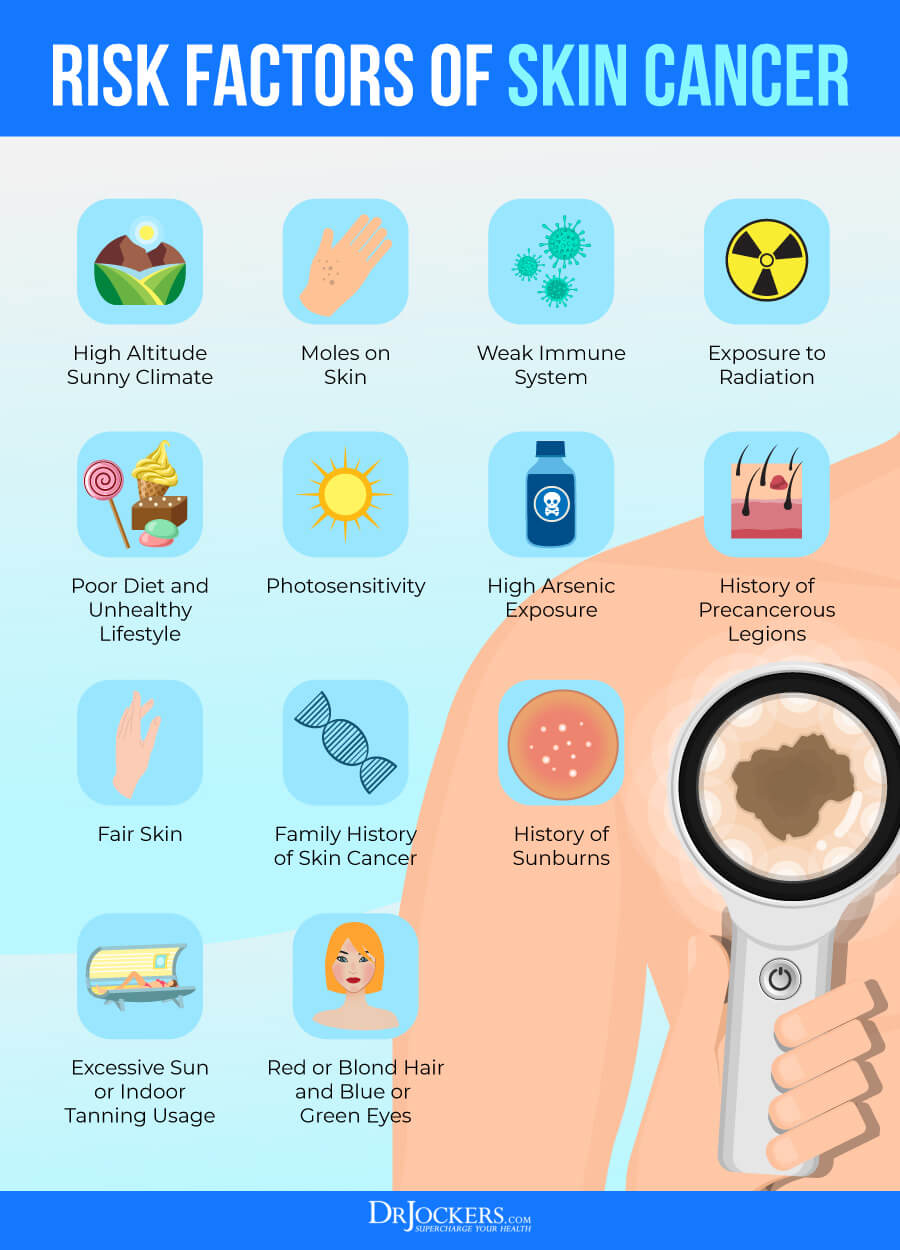
Diagnosing Skin Cancer
Early detection of skin cancer is important. As many as 99% of skin cancer cases are curable if diagnosed and treated early enough. Skin cancer is usually visible, so at home exams are important. If you notice a suspicious area on your skin, be sure to see a doctor to have the area checked.
To diagnose skin cancer, your doctor may examine your skin and do a biopsy of suspicious areas. A sample of skin is removed and examined under a microscope to determine whether the skin is cancerous or malignant.
Once the doctor determines skin cancer, additional tests are done to determine the stage of the skin cancer. Doctors use Roman numerals I through IV to indicate the extent of the cancer. Stage I cancers are small and limited to the area where they began. Stage IV indicates advanced cancer that has spread to other areas of the body.

Conventional Treatments for Skin Cancer
Conventional treatment options for skin cancer and the precancerous skin lesions known as actinic keratoses will vary, depending on the size, type, depth, and location of the lesions. Small skin cancers limited to the surface of the skin may not require treatment beyond an initial skin biopsy that removes the entire growth.
If additional treatment is needed, options may include:
- Your doctor may destroy actinic keratoses and some small, early skin cancers by freezing them with liquid nitrogen (cryosurgery). The dead tissue sloughs off when it thaws.
- Excisional surgery. This type of treatment may be appropriate for any type of skin cancer. Your doctor cuts out (excises) the cancerous tissue and a surrounding margin of healthy skin. A wide excision that removes extra normal skin around the tumor may be recommended in some cases.
- Mohs surgery. This procedure is for larger, recurring, or difficult-to-treat skin cancers, which may include both basal and squamous cell carcinomas. It’s often used in areas where it’s necessary to conserve as much skin as possible, such as on the nose.
During Mohs surgery, your doctor removes the skin growth layer by layer, examining each layer under the microscope, until no abnormal cells remain. This procedure allows cancerous cells to be removed without taking an excessive amount of surrounding healthy skin.
- Curettage and electrodesiccation or cryotherapy. After removing most of the growth, your doctor scrapes away layers of cancer cells using a device with a circular blade (curet). An electric needle destroys any remaining cancer cells. In a variation of this procedure, liquid nitrogen can be used to freeze the base and edges of the treated area.
- Radiation therapy. Radiation therapy uses high-powered energy beams, such as X-rays, to kill cancer cells. Radiation therapy may be an option when cancer cannot be completely removed during surgery.
- In chemotherapy, drugs are used to kill cancer cells. For cancers limited to the top layer of skin, creams or lotions containing anti-cancer agents may be applied directly to the skin. Systemic chemotherapy can be used to treat skin cancers that have spread to other parts of the body.
- Photodynamic therapy. This treatment destroys skin cancer cells with a combination of laser light and drugs that make cancer cells sensitive to light.
- Biological therapy. Biological therapy uses your body’s immune system to kill cancer cells.
Melanoma is an immunogenic cancer, meaning it is prone to inducing an immune response. Researchers are using immune-based treatments for advanced melanoma (3).
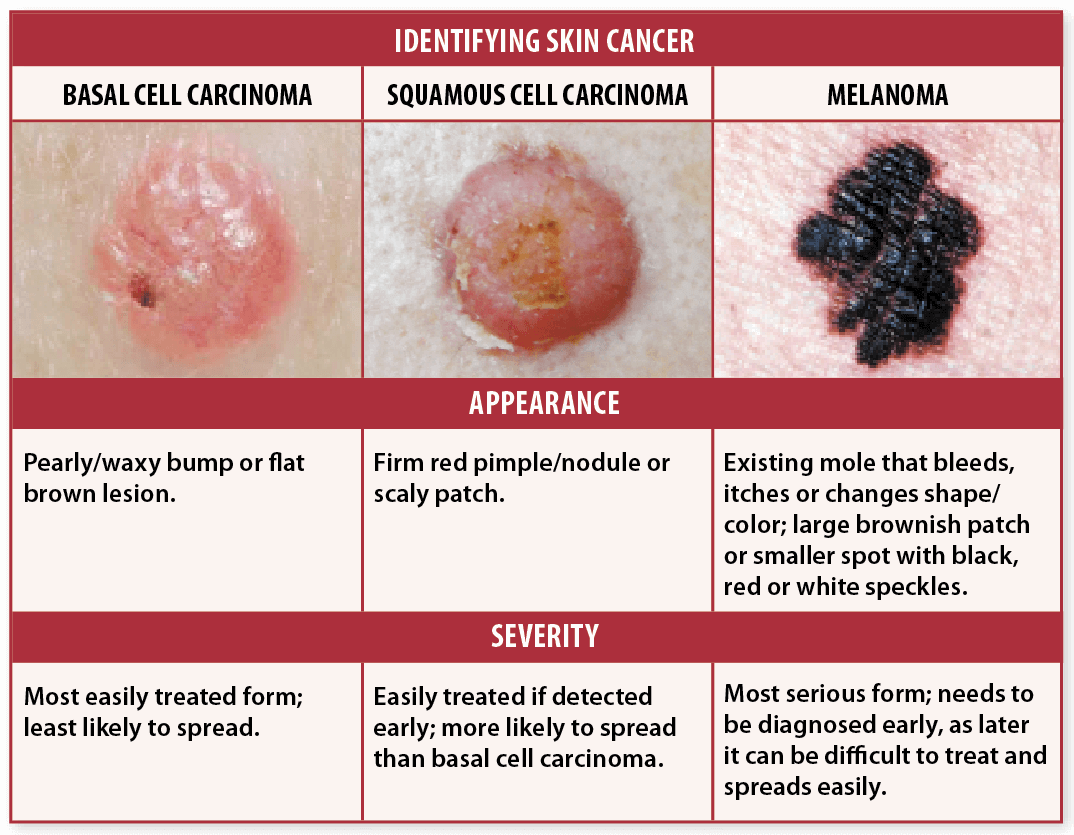
Skin Cancer Support Strategies
There are natural strategies that may be helpful for preventing skin cancer or supporting the healing process if you have skin cancer.
1. Smart Sun Exposure
You can reduce your risk of skin cancer by limiting or avoiding exposure to ultraviolet (UV) radiation. UV radiation is shown to be a complete carcinogen (4).
When UV light hits the surface of the skin, it generates free radicals. Free radicals are highly unstable oxygen molecules that produce inflammation and damage cell function and your skin’s DNA. This DNA damage can lead to skin cancer.
Avoid being in the sun in the middle of the day, between 10 a.m. and 4 p.m. This is when the sun is the strongest and the most damage to your skin occurs. Sunburns and suntans are signs that your skin is damaged. The more damage, the more likely you are to have complications. Also, consider adding a window shield in your vehicle, and remember that the sun can reflect off of sand, concrete, and other surfaces.
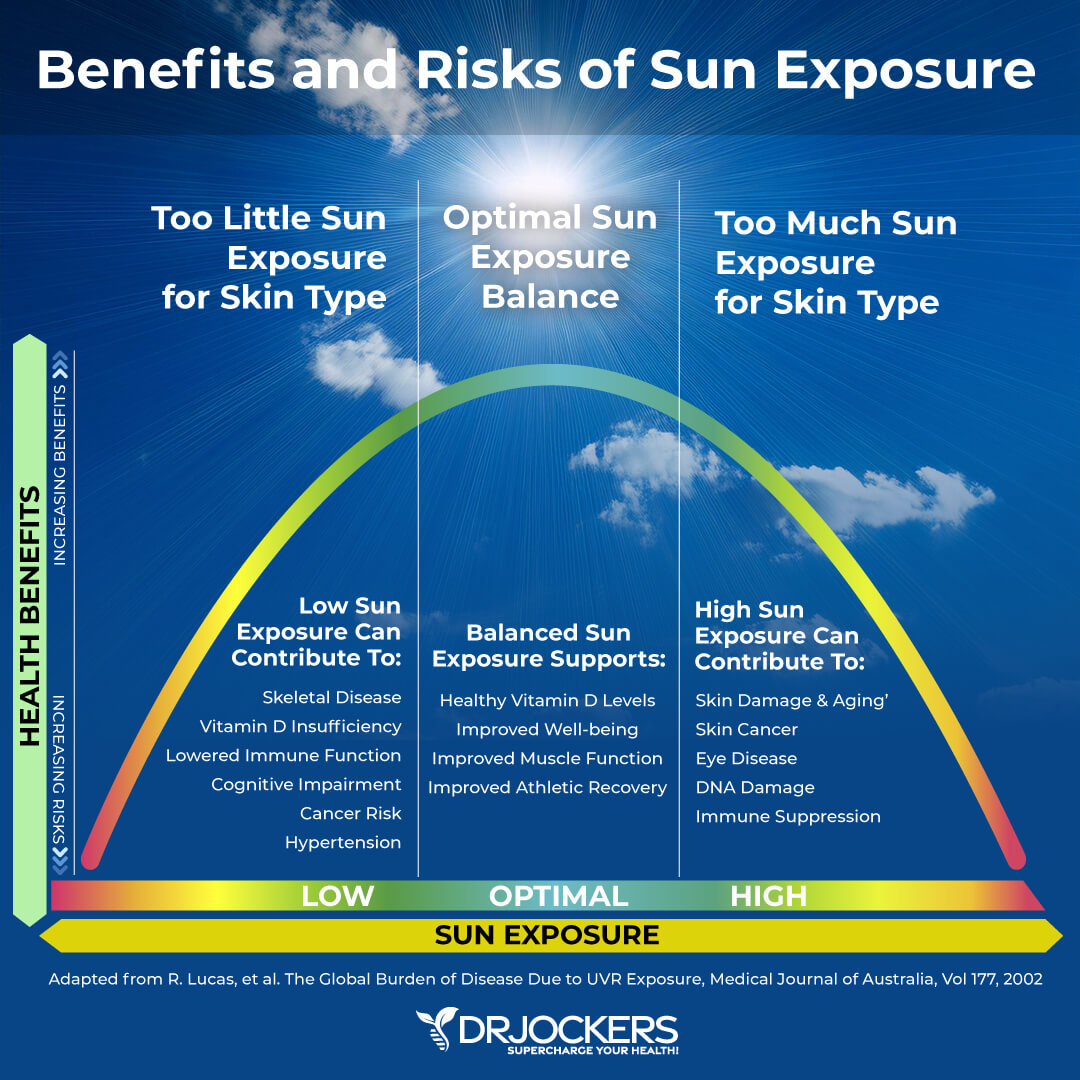
2. Avoid Indoor Tanning
While sunlight is the main source of UV radiation, indoor tanning devices (beds and lamps) also emit UV radiation. In fact, indoor tanning devices can emit UV radiation in amounts 10 to 15 times higher than the sun at its peak intensity (1).
More than 419,000 cases of skin cancer in the U.S. each year are linked to indoor tanning. Indoor tanning dramatically increases your risk of developing skin cancer and should be avoided.
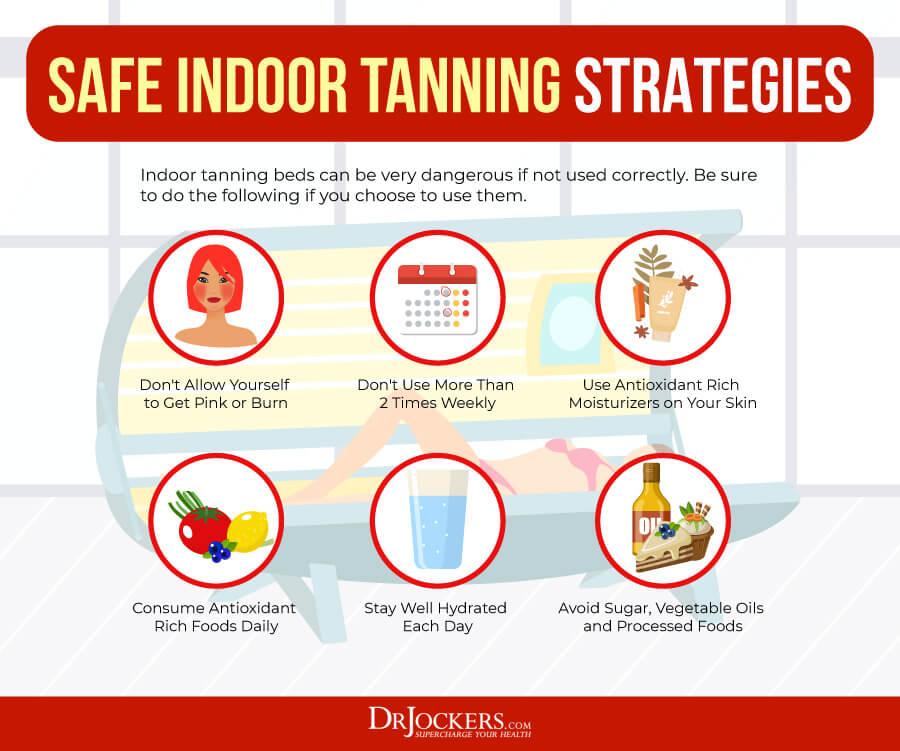
3. Use Natural Sunscreen
When in the sun for extended periods, be sure to use plenty of sunscreen. Apply sunscreen at least 15 minutes before you go into the sun to everywhere your skin is exposed. This includes your ears, the back of your neck, and any bald areas on the top of the head. Apply more sunscreen at least every 2 hours and after swimming, sweating, or toweling off.
Be sure to use natural sunscreens. Many sunscreens contain toxic chemicals that have been shown to absorb systemically in the body (5). To find a list of safe sunscreens, check out the guide to sunscreens put out by the Environmental Working Group (EWG).

4. Wear Protective Clothing, Hats, and Sunglasses.
Sunscreen cannot give you 100% protection against the sun’s harmful UV radiation. If you have to be out in the sun for extended times, cover up your skin.
Wear protective clothing, such as long-sleeved shirts and long pants made of tightly woven fabric. A wide-brimmed hat will help protect your face, neck, and ears. Also, wear sunglasses to protect your eyes. Choose sunglasses that protect the sides of your eyes and block both UVA and UVB rays.
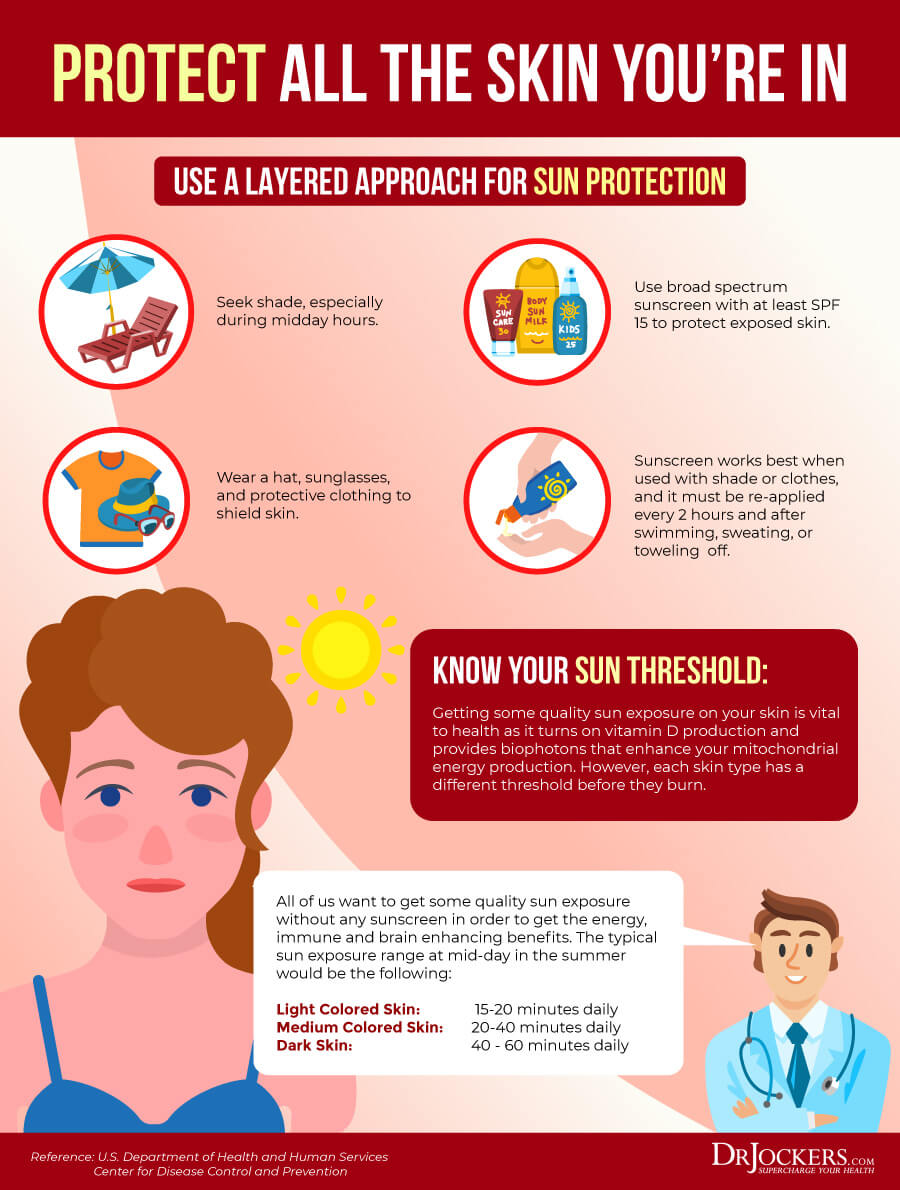
5. Plant-Based Ketogenic Diet
The best nutrition plan for individuals with cancer is a whole food, plant-based, ketogenic diet. The foundation of your diet should be a variety of organic, lower-carbohydrate, low-glycemic, colorful vegetables, fruits, and herbs. This nutrition plan is low in protein and high in healing fats such as avocados, olives, and coconuts.
The ketogenic diet is a nutrition and lifestyle plan that helps your body enter a state of ketosis. When your body is in nutritional ketosis, it utilizes ketones rather than glucose for fuel. Most tumor cells lack the metabolic flexibility to use ketones as an effective energy source (6). Being in ketosis deprives cancer cells of glucose while protecting and strengthening normal cells which can use ketones for energy (7).
The ketogenic diet has been shown to have anticancer effects through a variety of mechanisms, including:
- Inhibiting cancer cell glycolysis and proliferation
- Increasing cancer cell oxidative stress
- Being anti-angiogenic
- Lowering insulin levels
- Reducing inflammation
- Promoting apoptosis (programmed cell death)
Acting as an inhibitor of histone deacetylases (which reduces the ability of cancer cells to proliferate) (6,7,8,9).
The ketogenic diet can also improve the body’s response to other therapies like hyperbaric oxygen, ozone, and even conventional cancer treatments. For more information on using nutritional ketosis to fight cancer, read this article.
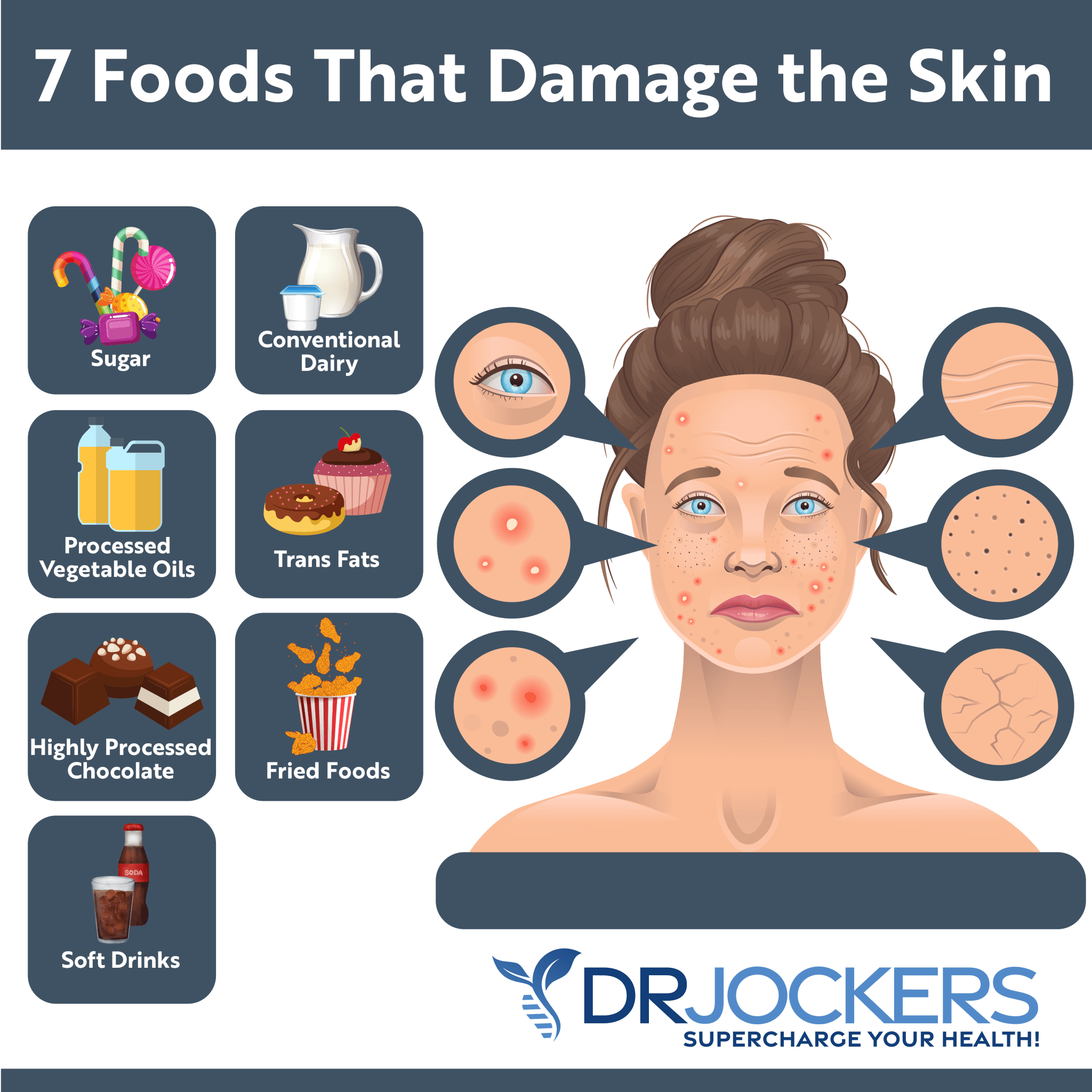
6. Phytonutrients and Antioxidants
Phytochemicals (or phytonutrients) and antioxidants protect the skin from cancer-causing free radicals (4). Phytonutrients are naturally occurring chemicals in plants that have antioxidant and anti-inflammatory benefits. They are what give vegetables and fruit their vibrant colors. Antioxidants are chemical substances found naturally in many foods that help to neutralize damaging free radicals.
Vegetables, fruits, and herbs contain abundant antioxidants and phytonutrients with anti-cancer benefits. (4). Phytochemicals include carotenoids (beta carotene, lycopene, and lutein), polyphenols, flavonoids, indoles, and isoflavones.
A few of the main antioxidants are vitamin A, vitamin C, vitamin E, and selenium. Dietary intake of these vitamins is inversely proportional to the risk of cancer and prevents skin carcinogenesis as antioxidant micronutrients (10).
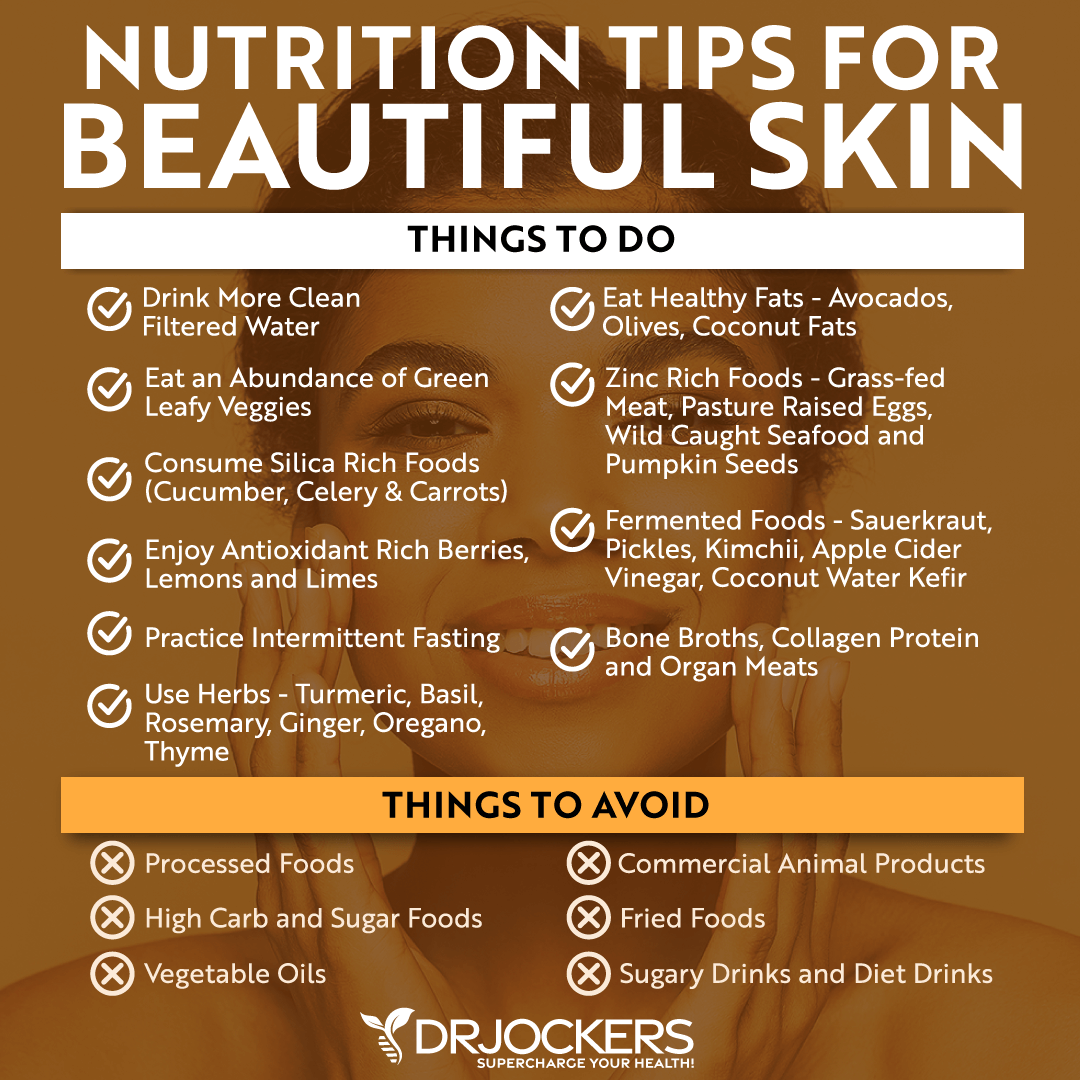
Vitamin E
Vitamin E is a fat-soluble antioxidant that is essential for the maintenance of healthy skin. The primary role of vitamin E is to prevent damage induced by free radicals and reactive oxygen species. It absorbs the energy from UV light and has anti-inflammatory properties (11).
Vitamin A
Vitamin A is an essential vitamin that supports growth and development, as well as eye health, reproductive health, and skin health. It is present in many fruits and vegetables in the forms of beta-carotene, alpha-carotene, and beta-cryptoxanthin. Vitamin A is also in animal products such as eggs, check, and beef liver in the form of retinol (preformed vitamin A). Vitamin A intake is associated with a reduction in cutaneous squamous cell carcinoma development (12).
Retinol and its derivatives are essential for the growth, differentiation, and maintenance of normal epithelial cells. They bind to nuclear receptors and regulate gene transcription. This includes changes that may ultimately decrease cell growth and help block malignant transformation.
Retinoids inhibit growth-stimulating signals and induce a multitude of downstream signaling pathways that regulate apoptosis, growth arrest, and cell differentiation in both precancerous and cancerous lesions.
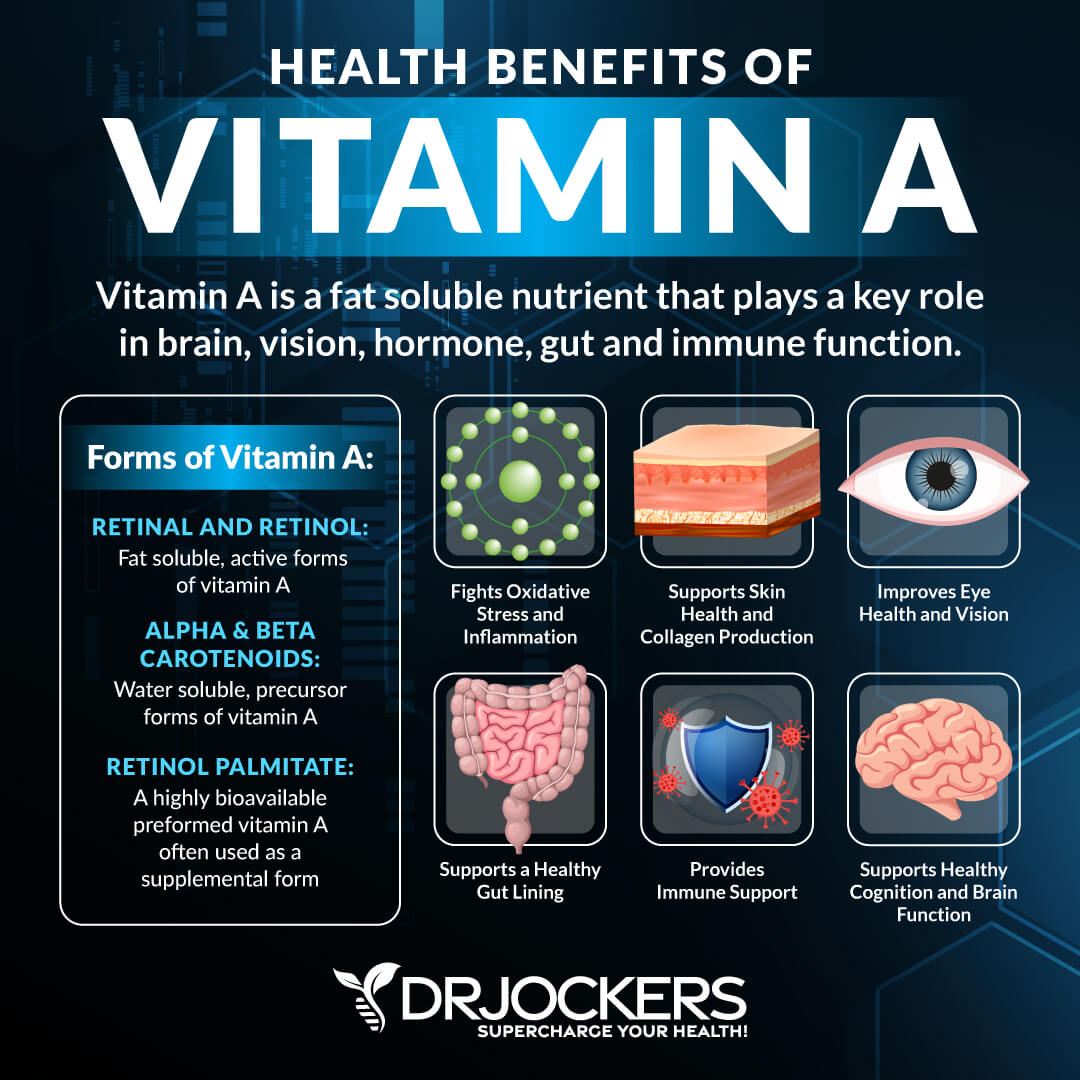
Resveratrol
Polyphenols are phytochemicals found in black and green tea, wine, fruits, vegetables, and olive oil. They have powerful antioxidant, immunomodulatory, anti-inflammatory, and tumor-inhibiting properties. Polyphenols have DNA repair capability and photoprotective benefits on dysregulated cellular signaling (13). These powerful compounds may help to prevent skin cancer.
Resveratrol is a natural polyphenol produced by red grapes. It is a strong antioxidant and free radical scavenger with anti-inflammatory and anti-tumoral effects. Studies show that resveratrol has antitumor activity on several cancers and on organ-specific and systemic autoimmune conditions (14).
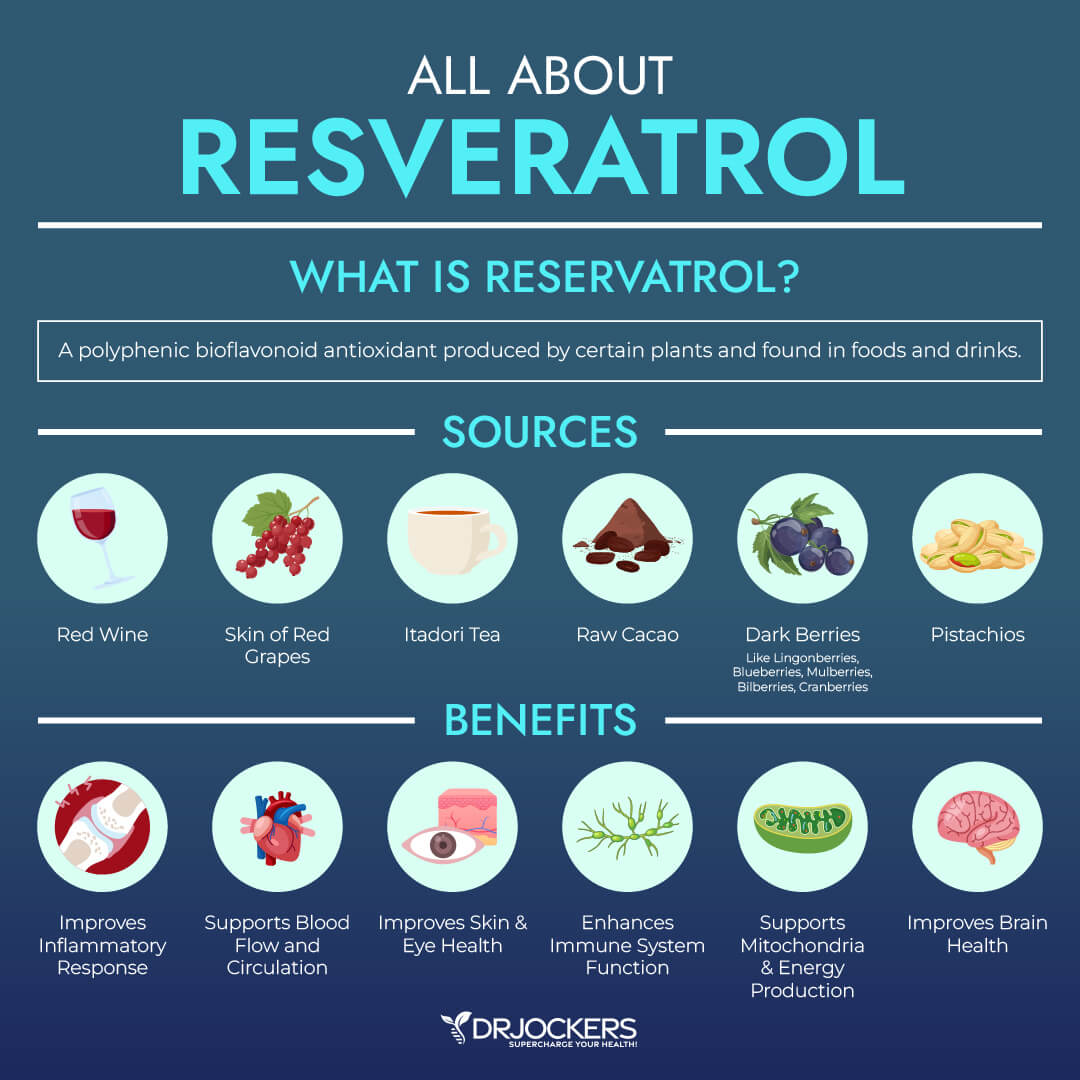
Quercetin
Quercetin is a polyphenol, a powerful antioxidant, and the “king of flavonoids.” Quercetin is found in many vegetables and fruits, including red onions, apples, berries, parsley, olive oil, citrus fruits, cocoa, tea, and red wine.
Quercetin has the potential to both prevent and treat cancer, including melanoma (15). It can increase p53 and Nrf2. The p53 gene regulates what happens to damaged DNA sequences before they lead to problems in cell development. This critical gene is inactive in many cancers. Nrf2 (NF-E2-related factor 2) is a transcription factor in humans encoded by a specific gene that regulates the expression of a set of antioxidant and detoxifying genes.
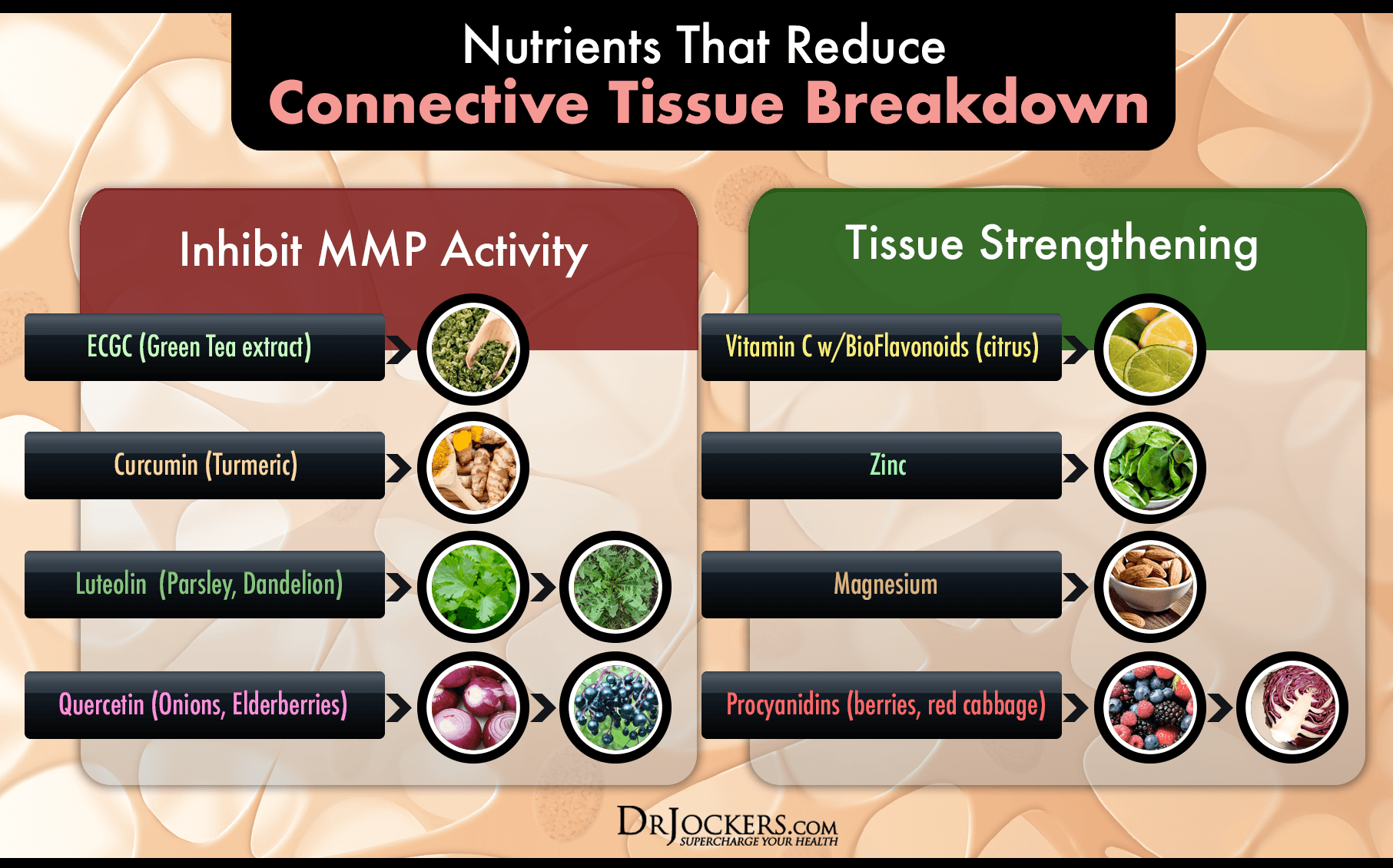
Lycopene
Lycopene is the primary carotenoid of tomatoes. It is the red pigment in tomatoes that helps protect them from the sun.
It may also protect your skin. Studies suggest that lycopene imparts a photoprotective effect against UV-dependent skin damage (4). In addition to tomatoes, you can find lycopene in foods like watermelon, papaya, guava, apricots, and pink grapefruit.
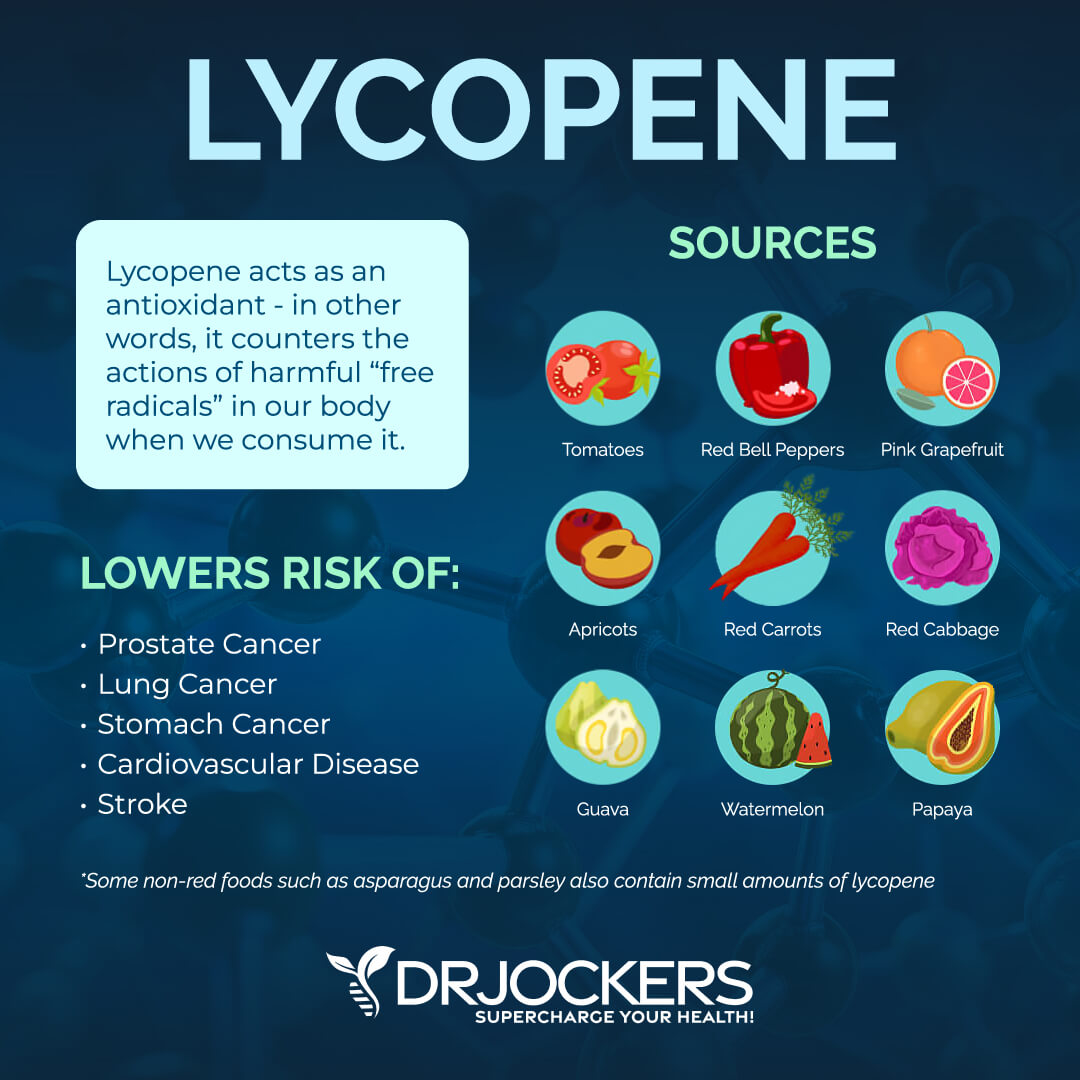
7. Detoxification Strategies
When fighting any cancer, it is critical to minimize your exposure to toxins. One major source of toxins is in our food. Certain foods increase inflammation, create acidity in the tissues, and drive cancer growth. Foods that should be avoided include:
- Sugar
- Refined carbohydrates (white flour, white rice, white potatoes)
- Conventionally raised meat and dairy
- Farm-raised fish
- Processed meats
- Processed foods
- Trans fats (partially hydrogenated oils)
- Mono-sodium Glutamate (MSG) and other food additives and preservatives
- Processed vegetable and seed oils, such as canola, corn, sunflower, peanut, grapeseed, cottonseed, and safflower
- Artificial Sweeteners.
You should also avoid chemicals and toxins found in personal care products, cleaning supplies, tap water, and more.
Since it is impossible to eliminate exposure to all toxins, using detoxification strategies is important. Juicing, coffee enemas, sauna, lymphatic cleansing, physical exercise, breathing exercises, heavy metal detoxification, and regular bowel movements are all pathways to eliminate toxins.
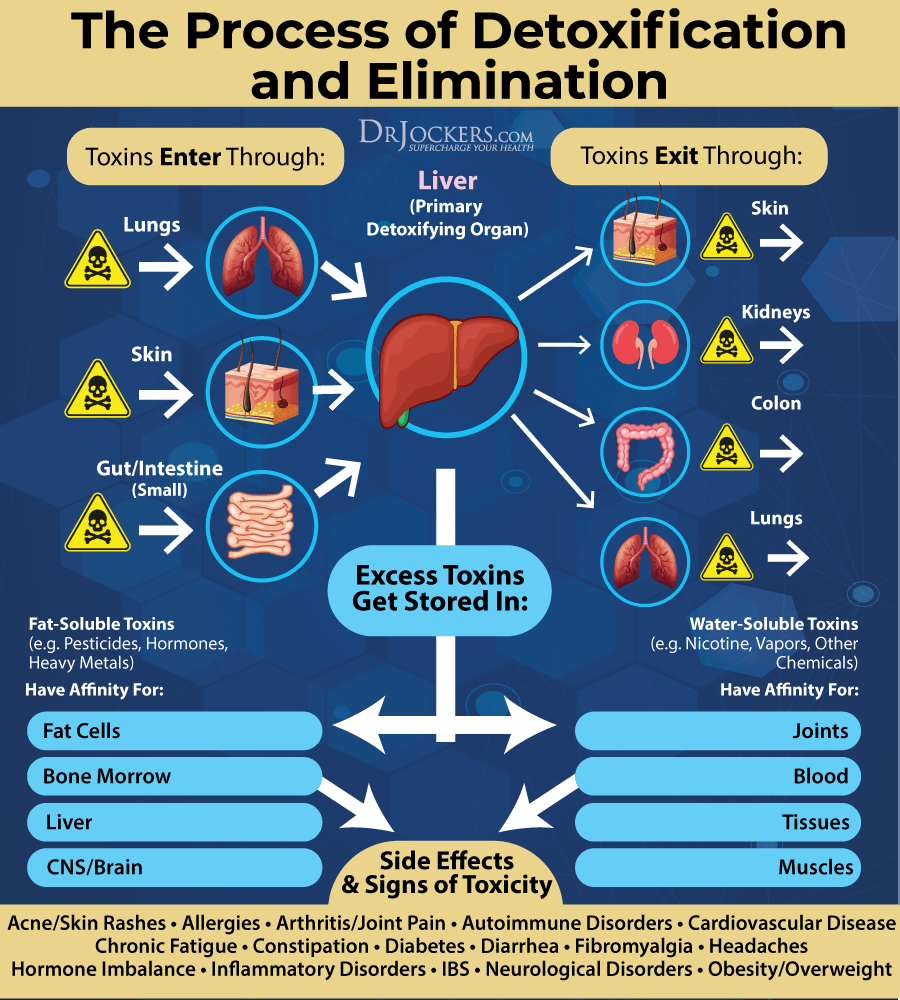
8. Optimal Hydration
Water is a vital nutrient to the life of every cell. About 64% of the skin is made up of water. This means that dehydration, even in small amounts, can negatively affect the skin. Water supports many functions of the body by improving oxygen delivery to cells, transporting nutrients, flushing toxins, and supporting the body’s natural healing processes.
To be well hydrated, you should consume at least one-half and up to your full body weight in ounces of water every day. For example, a 130-pound individual should consume a minimum of 65 ounces and up to 130 ounces of water per day. For anyone with cancer, filtering chlorine, fluoride, heavy metals, and pharmaceutical drugs from your water with a high-quality filter is critical.

9. Apply Essential Oils
Used as healing agents across cultures for centuries, frankincense and myrrh have extensive and significant pharmacological effects. Studies show that both frankincense and myrrh have anti-inflammatory and anti-cancer effects (16).
The main bioactive substances of frankincense are Bas whose main pharmacological effects are anti-inflammatory and anticancer. The triterpenoids in frankincense, AKBA, and KBA, have the strongest anticancer activity and are expected to become candidates for anticancer drugs.
The main bioactive substances of myrrh are sesquiterpenes and GS, and its main pharmacological action is anticancer. When used together, these oils work synergistically, and their combined effect is being studied further.
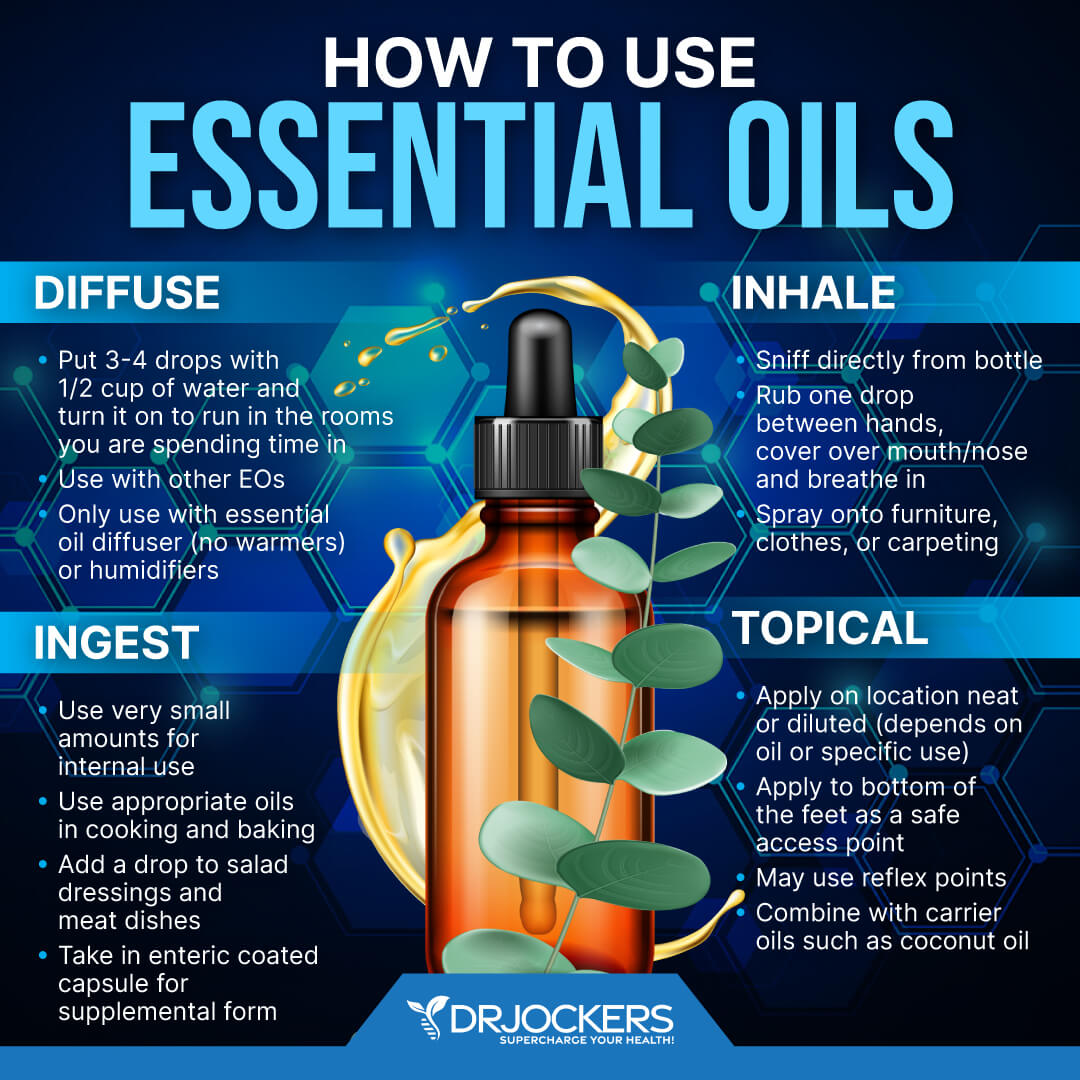
10. Support Immune Health
A weakened or dysfunctional immune system is often a factor in cancers, including skin cancer. Supporting immune system function with antioxidants and nutrients may help to normalize immune system function.
Nutrients to modulate immune health include zinc, vitamin C, olive leaf, and beta-glucan. Zinc helps keep the immune system functioning efficiently to fight cancer and other diseases. It also helps activate certain antioxidants in the body.
Olive leaf is a powerful herb with antibacterial, antifungal, and antiviral effects. It inhibits viral reproduction and supports the immune system in fighting pathogens. Beta-glucan is a balancing immune modulator that helps to bind to white blood cells and improve their immune coordination. Vitamin C is an antioxidant that supports immune system function.
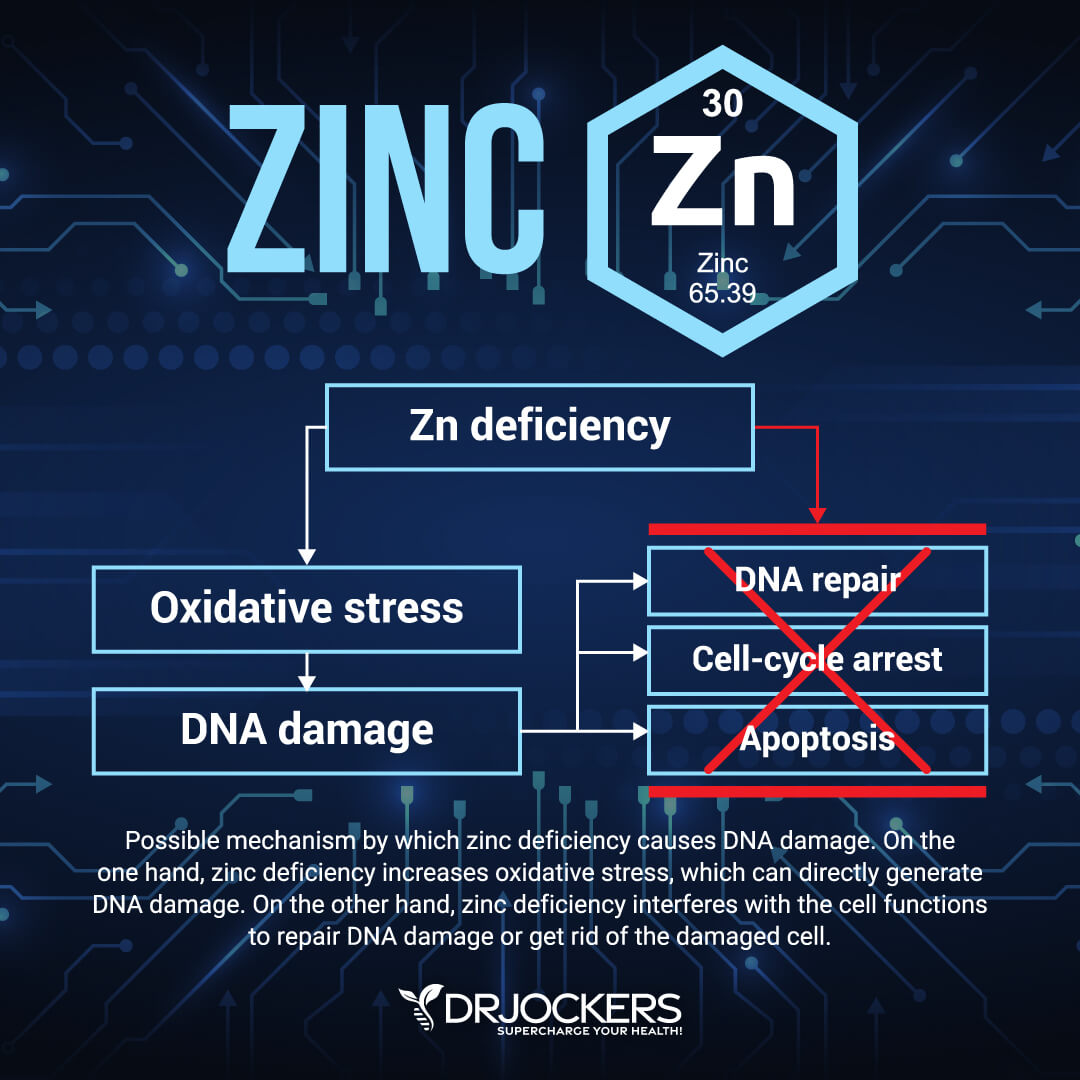
11. Enhance Skin Autophagy
Autophagy is your intracellular recycling system and cellular self-degradation process where your body cleans out debris and recycles damaged cell components. This leads to the regeneration of cells.
Cells use autophagy to maintain biological function, homeostasis, quality control of cell contents, and eliminate old proteins and damaged lipids and organelles. (17). Autophagy enables cells to survive external stressors like nutrient deprivation and internal stressors like pathogens.

12. Optimize Vitamin D Levels
Studies have shown that the risk of developing skin cancer is lower in people with high vitamin D levels. Vitamin D has anti-cancer effects on skin cancer through a variety of mechanisms (18). Recent data also suggests that vitamin D may influence the DNA damage response to promote the survival of cancer patients.
Vitamin D3 is created in your skin in response to sun exposure. The best dietary sources of vitamin D are wild-caught salmon and fatty fish, cod liver oil, grass-fed butter and raw cheese, egg yolks, mushrooms, and beef liver.
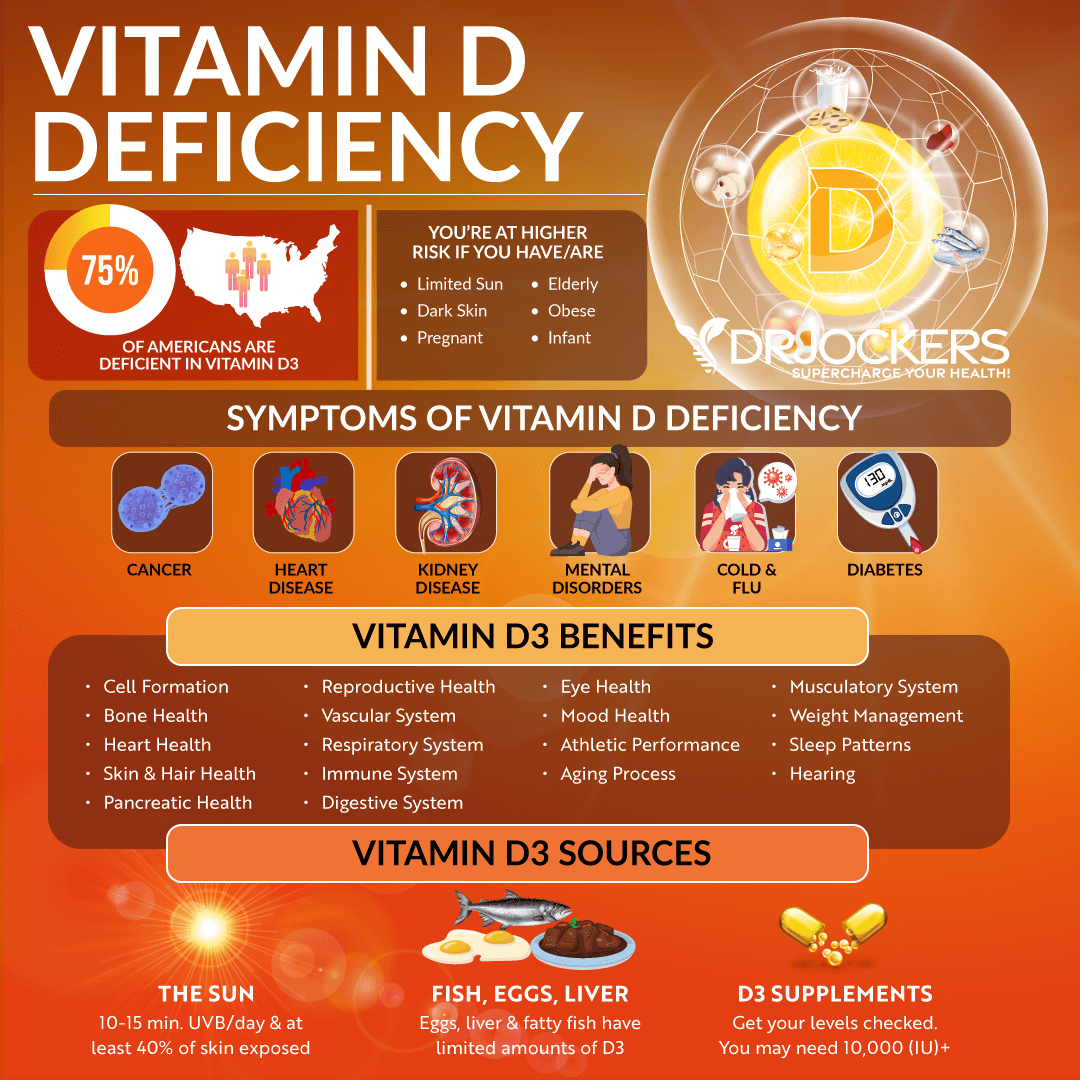
13. Herbs and Spices as Nutraceuticals
Herbs and spices are known to have a plethora of health benefits. They are considered “nutraceuticals,” a food-derived substance that has a medical benefit in preventing illness and promoting health (19).
Herbs and spices have been used as herbal therapies for centuries in many different cultures around the world. Spices have anti-inflammatory, anti-proliferation, anti-microbial, and antioxidant properties. A growing body of evidence shows that spices are potential anti-cancer agents.
There are a number of studies showing the effectiveness of herbs and spices to prevent and treat skin cancer. These include turmeric, ginger, garlic, cloves, rosemary, saffron, and capsaicin. These herbs and spices work through several mechanisms to prevent and protect against many cancers, including skin cancer.
Conclusion
Skin cancer is the most common type of cancer. The main types of skin cancer are squamous cell carcinoma, basal cell carcinoma, and melanoma. Melanoma is less common than the other types, but it is more aggressive.
One of the most important natural strategies is avoiding excessive sun exposure and indoor tanning devices. Other strategies include a clean, plant-based ketogenic diet, incorporating foods rich in phytochemicals and antioxidants, using detoxification strategies, good hydration, using essential oils, optimizing vitamin D, supporting immune health, and enhancing skin autophagy.
If you want to work with a functional health coach, I recommend this article with tips on how to find a great coach. On our website, we offer long-distance functional health coaching programs. For further support with your heart health and other goals, just reach out—our fantastic coaches are here to support your journey.
Inflammation Crushing Ebundle
The Inflammation Crushing Ebundle is designed to help you improve your brain, liver, immune system and discover the healing strategies, foods and recipes to burn fat, reduce inflammation and Thrive in Life!
As a doctor of natural medicine, I have spent the past 20 years studying the best healing strategies and worked with hundreds of coaching clients, helping them overcome chronic health conditions and optimize their overall health.
In our Inflammation Crushing Ebundle, I have put together my very best strategies to reduce inflammation and optimize your healing potential. Take a look at what you will get inside these valuable guides below!
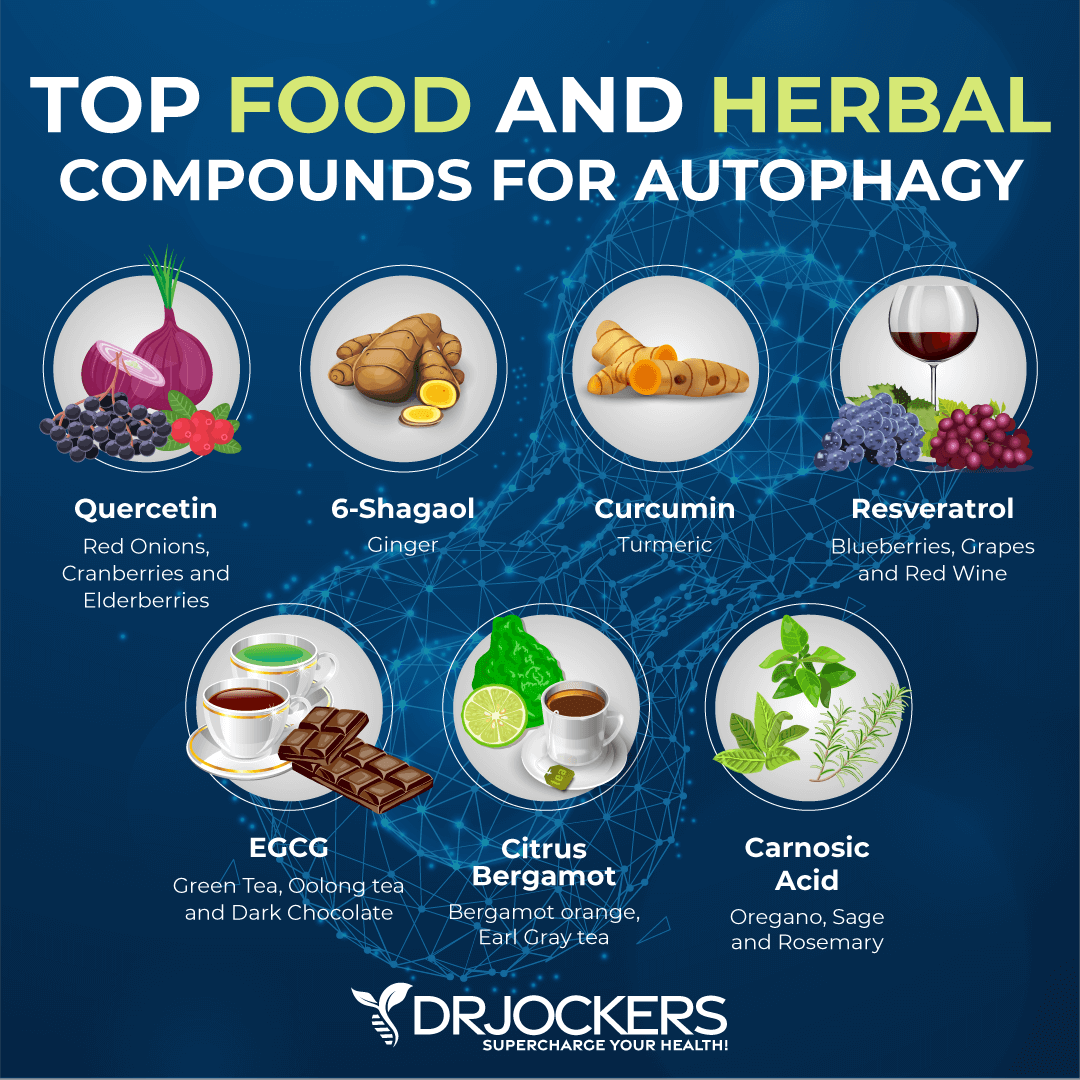





In fact, it is very important to be constantly aware of what such an unpleasant disease as skin cancer can arise from, because sometimes it is not even clear how it could appear and what to fear. And this topic is very sensitive because many people do not even realize that they can carry cancer in the early stages and are in great danger because of this.
Dr. Jockers,
I notice that you do not have any information on bone cancer or (MGUS). Do you have anything on healing bone cancer?
Thank you for you input.
We do not have that at this point, but will write a detailed article on bone cancer in the future.